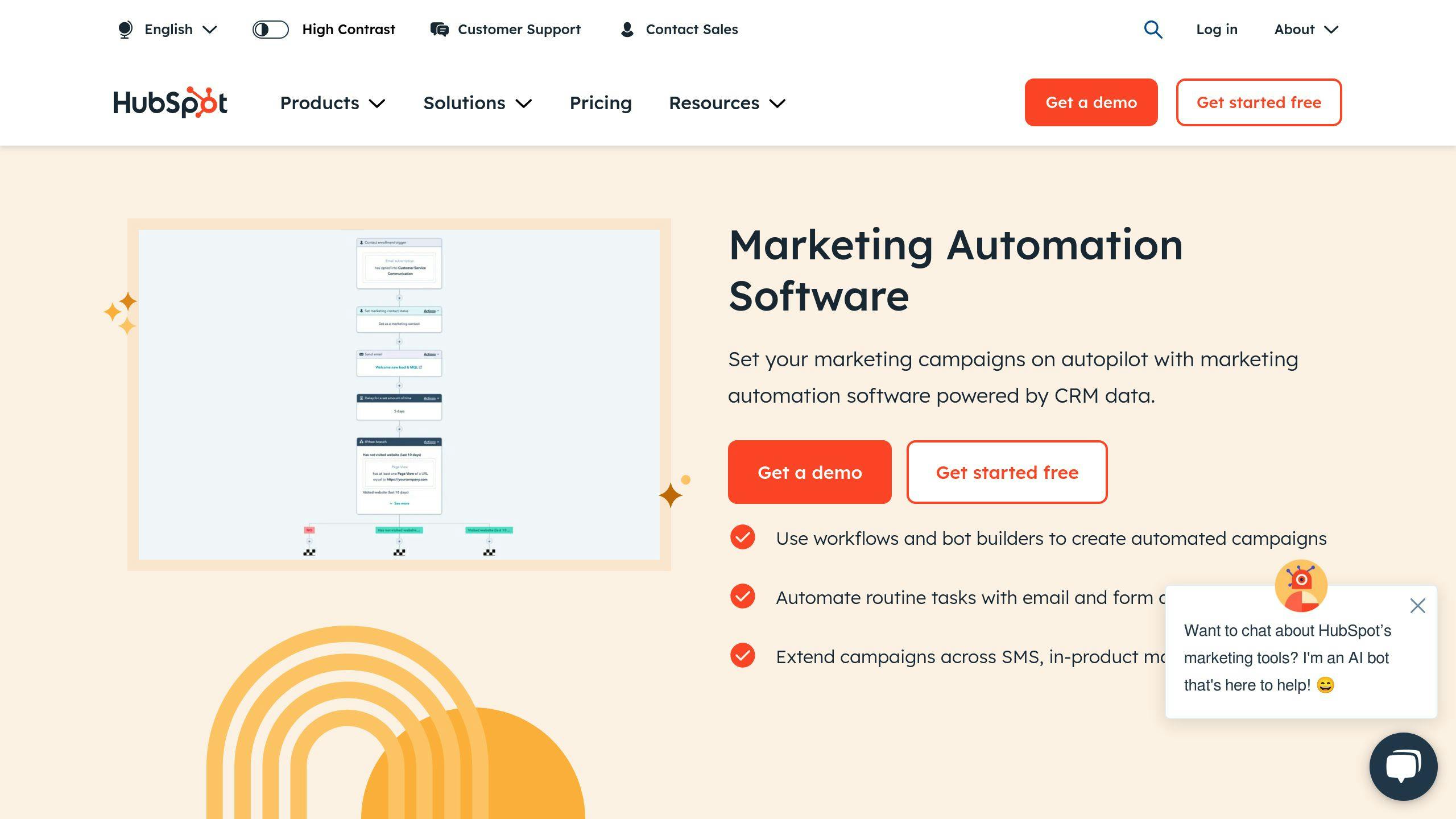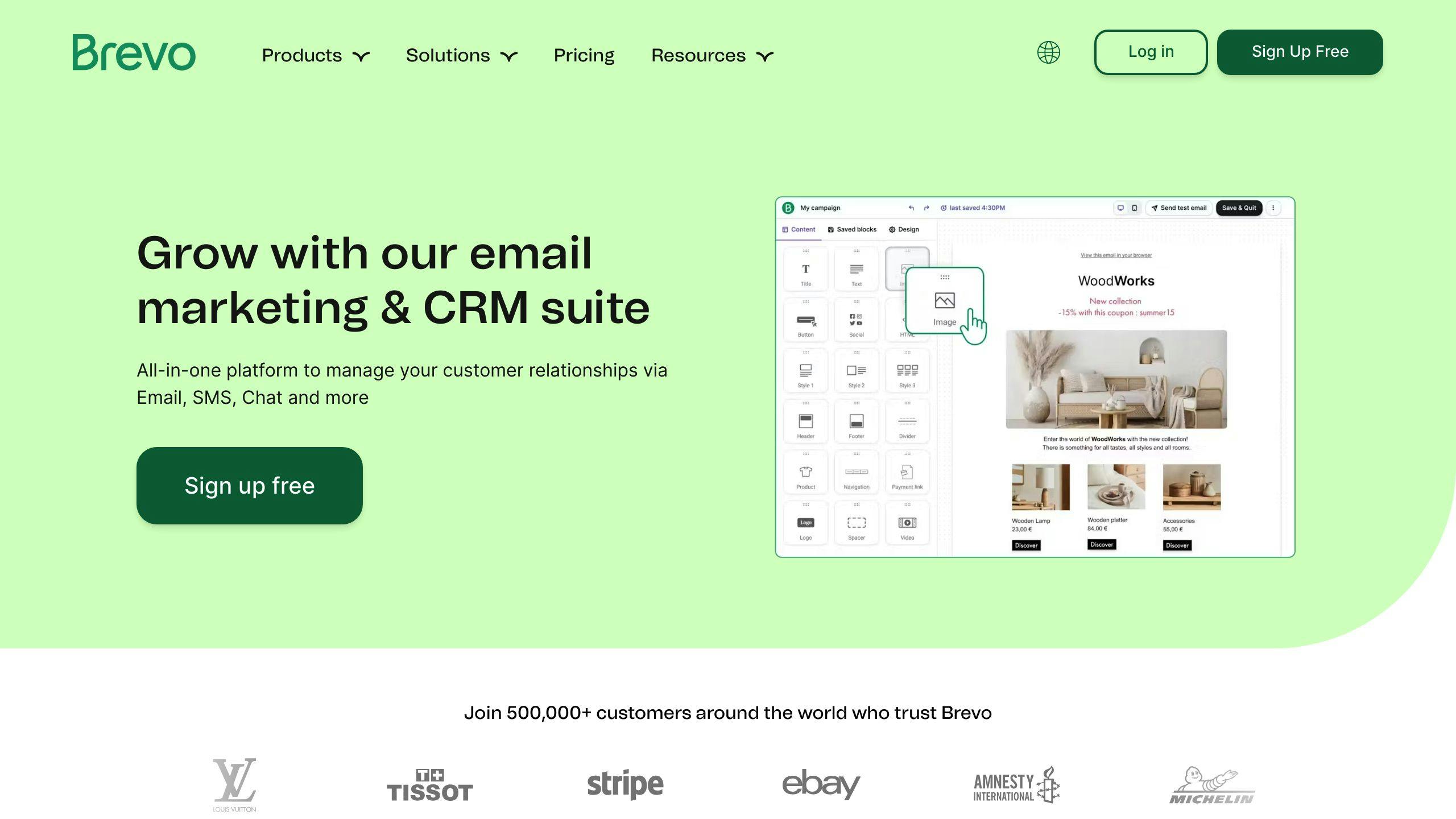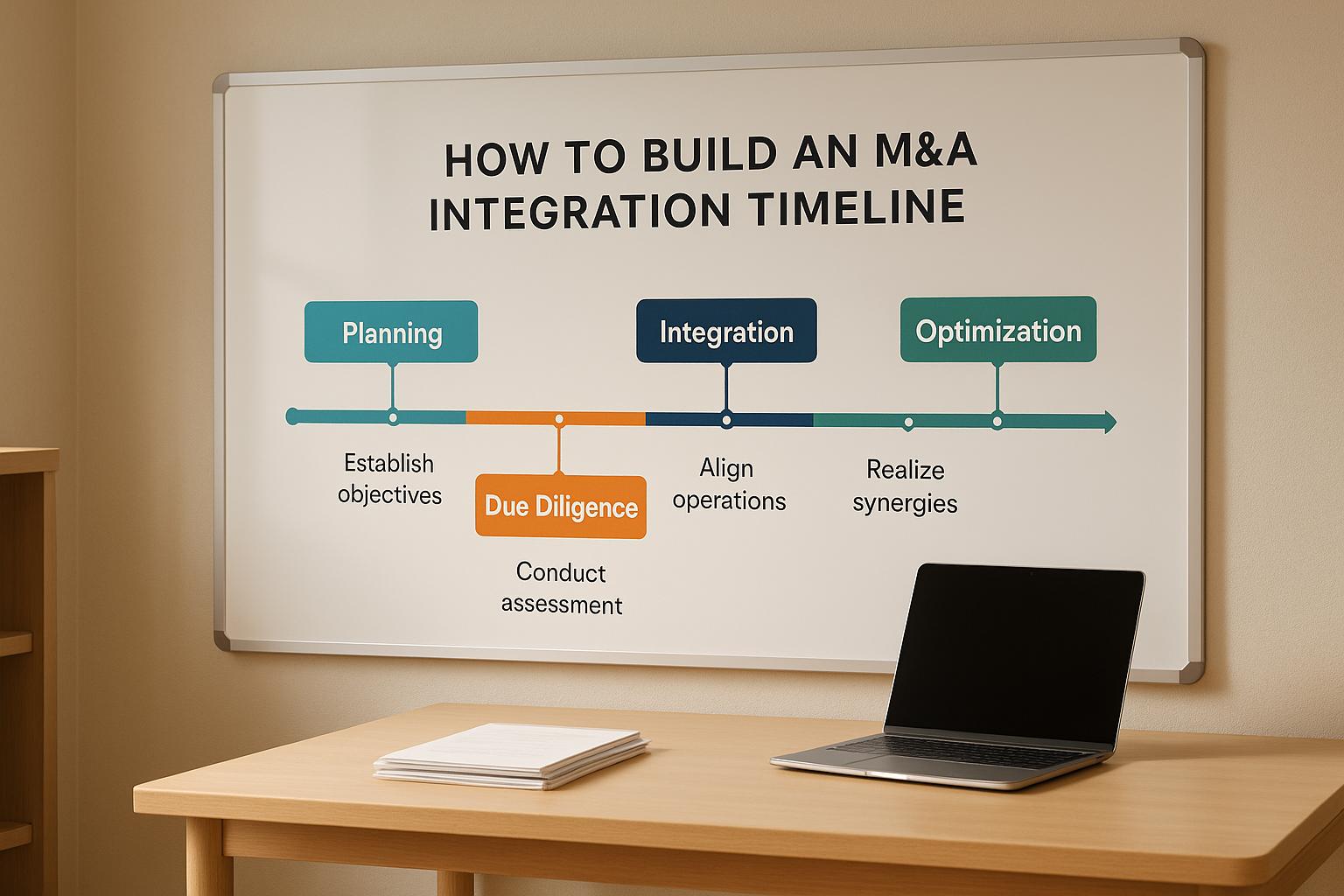Want to grow your B2B business while saving time? Lifecycle marketing automation helps you engage customers at every stage - from acquiring leads to retaining loyal clients. By using tools like HubSpot, ActiveCampaign, and Brevo, you can automate tasks, personalize messages, and boost ROI.
Key Benefits of Lifecycle Marketing Automation:
- Lower Costs: Reduce acquisition costs by up to 23%.
- Better Retention: Cut churn rates by 40%.
- Higher Revenue: Increase customer lifetime value by 20%.
How It Works:
- Acquisition: Automate lead scoring and qualification.
- Engagement: Deliver personalized content based on behavior.
- Conversion: Use nurture sequences to close deals.
- Retention: Automate check-ins and upsell campaigns.
Tools to Consider:
| Tool | Best For | Key Features |
|---|---|---|
| HubSpot | Full lifecycle management | Lead scoring, analytics, dashboards |
| ActiveCampaign | Engagement & conversion | Predictive sending, sales automation |
| Brevo | Retention & communication | Email/SMS automation, behavior-triggered campaigns |
With the right tools and strategies, lifecycle automation ensures smarter, more efficient marketing that drives growth. Let’s explore how to implement it effectively.
The Expert Guide to HubSpot Lifecycle Stages

Breaking Down the B2B Customer Lifecycle
Automation plays a key role in every stage of the B2B customer lifecycle, helping marketers create more effective strategies. Here's how automation can make a difference at each phase.
Acquisition: Attracting New Leads
Automation tools make lead scoring easier by analyzing factors like engagement and demographics. For example, they can track website visits, content downloads, or form submissions to trigger customized workflows, increasing the chances of turning leads into customers.
Engagement: Building Stronger Relationships
Tools like ActiveCampaign and Brevo help craft content journeys based on individual user behaviors and preferences [2][3]. By delivering tailored experiences, businesses can create stronger connections that lead to smoother transitions toward conversion.
Conversion: Turning Leads Into Customers
When it’s time to convert, automation ensures the process is efficient. Tools like HubSpot handle timely email campaigns, follow-ups, and coordination with the sales team, making it easier to close deals [1].
Retention: Keeping Customers Loyal
Retention becomes more manageable with platforms like Brevo, which offer automated onboarding, regular check-ins, and personalized updates to keep customers engaged [3].
Research from The B2B Ecosystem reveals that businesses using lifecycle automation often see higher customer lifetime value and lower churn rates. Choosing the right tools is essential to ensure everything runs smoothly at every stage.
Best Tools for Lifecycle Marketing Automation
Choosing the right tools can make all the difference when it comes to automating B2B lifecycle marketing. Below, we break down some of the top platforms and how they support various stages of the customer journey.
HubSpot

HubSpot (G2 rating: 4.4/5) provides a comprehensive platform to manage all lifecycle stages. It's especially effective during the acquisition and engagement phases with features like:
- Unified customer data analytics for tailored interactions
- Advanced lead scoring to prioritize prospects
- Real-time engagement tracking for better insights
- Custom reporting dashboards to measure performance
ActiveCampaign

ActiveCampaign (G2 rating: 4.5/5) shines in the engagement and conversion stages by offering:
- Predictive sending to improve message timing
- Behavioral-based audience segmentation for targeted outreach
- Multi-channel campaign orchestration for cohesive messaging
- Sales automation workflows to streamline processes
Brevo

Brevo (G2 rating: 4.5/5) is ideal for retention and engagement. It stands out with:
- Email and SMS automation in one platform
- Visual customer journey mapping for easy tracking
- Behavior-triggered campaigns to enhance relevance
- Budget-friendly pricing for businesses just starting out
The B2B Ecosystem

The B2B Ecosystem focuses on strategic aspects of lifecycle marketing, offering tools like:
- GTM Brain for automated market analysis
- Offer Consultant to refine value propositions
- AI-driven customer journey mapping for smarter decisions
- Seamless integration with major marketing platforms
| Tool | Primary Focus | Best Fit |
|---|---|---|
| HubSpot | Full Lifecycle | Enterprise & Mid-market |
| ActiveCampaign | Engagement & Conversion | Mid-sized B2B |
| Brevo | Retention & Communication | Growing businesses |
| B2B Ecosystem | Strategy & Analysis | Custom solutions |
The secret to success? Aligning the tool with your specific goals. Once you've picked the right platform, focus on integrating it to automate and personalize every stage of your customer journey.
sbb-itb-01010c0
How to Implement Lifecycle Marketing Automation
Getting lifecycle marketing automation right means aligning the right tools with your business objectives. A structured approach ensures automation not only simplifies tasks but also boosts ROI and strengthens customer relationships.
Using Automation for Personalization
Personalization is all about knowing your audience and tailoring your approach to their needs. Focus on these three areas to get it right:
- Data Collection and Segmentation: Gather and analyze customer data to build detailed profiles. This allows for precise targeting and messaging that resonates.
- Trigger-Based Workflows: Automate actions based on customer behavior. For example, set up workflows to launch upsell campaigns when specific product usage patterns are detected.
- Dynamic Content Delivery: Use content blocks that adapt based on customer attributes, ensuring messages feel personal and relevant.
Making Data-Driven Decisions
Data is your compass for optimization. Regularly analyze clean, actionable data to uncover trends and fine-tune your approach. Key metrics to track include:
| Metric Type | Key Metrics | Purpose |
|---|---|---|
| Engagement | Open rates, click-through rates | Gauges message relevance |
| Conversion | Form completions, demo requests | Measures campaign success |
| Revenue | Customer lifetime value, ROI | Demonstrates business impact |
| Behavioral | Page visits, content downloads | Highlights customer preferences |
Connecting Automation Across Teams
To ensure smooth collaboration, create shared dashboards for transparency and automate lead handoffs between teams. Consistent workflows and standardized naming conventions help maintain alignment across departments.
Start with smaller initiatives and scale up over time to encourage team adoption and maximize returns. With these strategies in place, lifecycle automation becomes a powerful tool for driving growth and building stronger customer connections.
Why Lifecycle Marketing Automation Helps B2B Businesses
Lifecycle marketing automation plays a crucial role in helping B2B companies grow by strengthening customer relationships and driving measurable improvements in key performance metrics.
Boosting Customer Lifetime Value
Automating lifecycle marketing helps increase customer lifetime value (LTV) by building stronger relationships and creating opportunities for upselling. According to HubSpot, businesses using automated lifecycle marketing see a 20% rise in LTV within a year. Here’s how it works:
| Revenue Driver | Impact on LTV | Implementation Method |
|---|---|---|
| Repeat Purchases | +15% increase | Post-purchase follow-ups |
| Upsell Conversion | +25% higher rates | Behavior-triggered recommendations |
| Account Expansion | +30% growth | Usage-based upgrade prompts |
Lowering Customer Churn
Automation helps businesses tackle potential churn by addressing customer satisfaction issues early. Data from Brevo shows that B2B companies using automated engagement workflows can cut customer churn by 40%. This is achieved through:
- Early Warning Detection: Monitoring usage patterns and engagement levels.
- Proactive Solutions: Automated outreach when activity dips below expected levels.
- Value Reinforcement: Regular check-ins and sharing success stories to highlight value.
By retaining more customers, businesses not only improve satisfaction but also lower acquisition costs, boosting overall marketing efficiency.
Getting Better Marketing ROI
Lifecycle automation improves marketing efficiency while cutting operational costs. ActiveCampaign reports that its B2B clients achieve an average 23% reduction in customer acquisition costs after adopting automation.
Here’s a breakdown of how automation enhances ROI:
| Area | Cost Reduction | Performance Gain |
|---|---|---|
| Lead Nurturing | -35% resource hours | +45% conversion rate |
| Campaign Management | -40% manual work | +60% engagement |
| Customer Support | -25% response time | +50% satisfaction |
These gains make it easier for businesses to scale and adopt data-driven strategies for long-term success.
Final Thoughts on Lifecycle Marketing Automation
Success in lifecycle marketing automation relies on three key pillars that guide the customer journey from acquisition to retention:
| Key Pillar | Outcome |
|---|---|
| Data Integration | Better personalization through unified customer insights |
| Cross-Team Alignment | Consistent customer experience across all touchpoints |
| Continuous Optimization | Greater ROI through ongoing, data-driven improvements |
These pillars are the backbone of the lifecycle stages we covered earlier. They help businesses build stronger customer relationships while streamlining operations. For example, companies using well-planned automation strategies often achieve a 14.5% increase in sales productivity and cut marketing costs by 12.2% [3].
Modern automation platforms are constantly advancing, offering tools that align with these core principles. But the real success lies in how organizations:
- Combine customer data from various systems
- Unite teams around shared objectives and metrics
- Regularly evaluate and refine automation workflows
- Stay focused on tracking measurable results
The B2B Ecosystem's AI tools and consulting services are designed to help companies put these ideas into action, creating automation strategies that support growth and efficiency.


